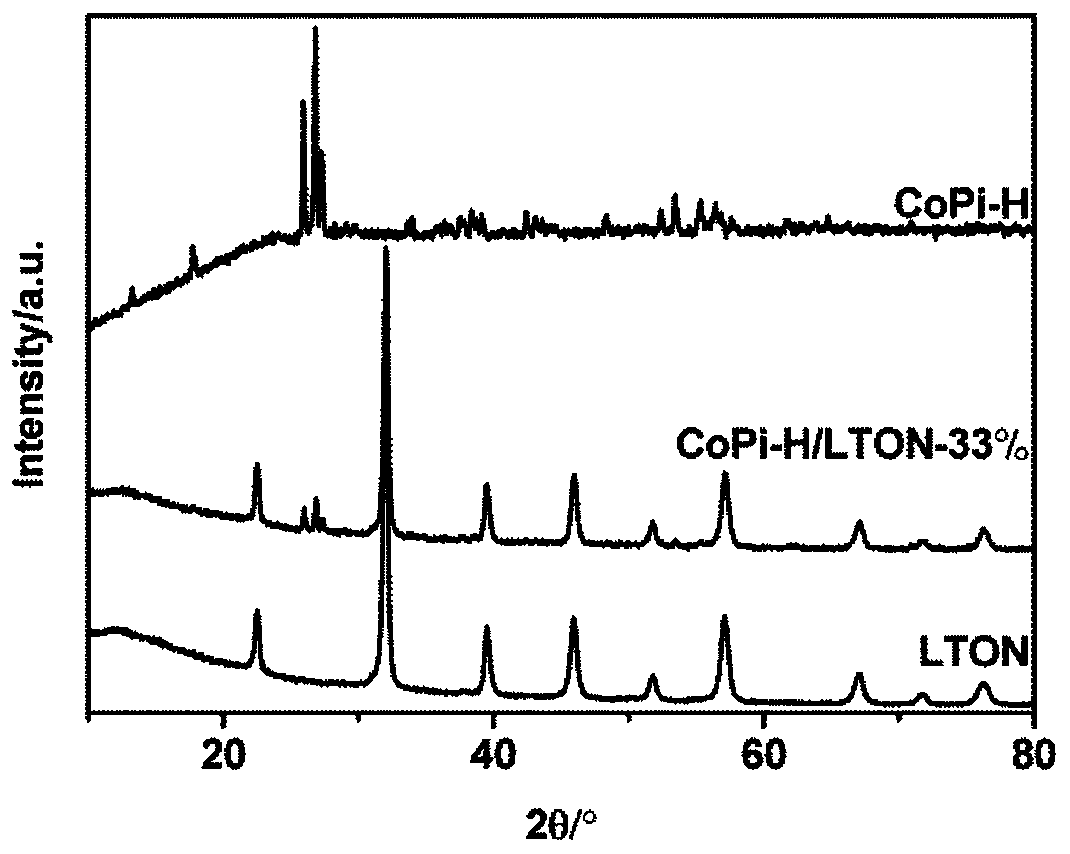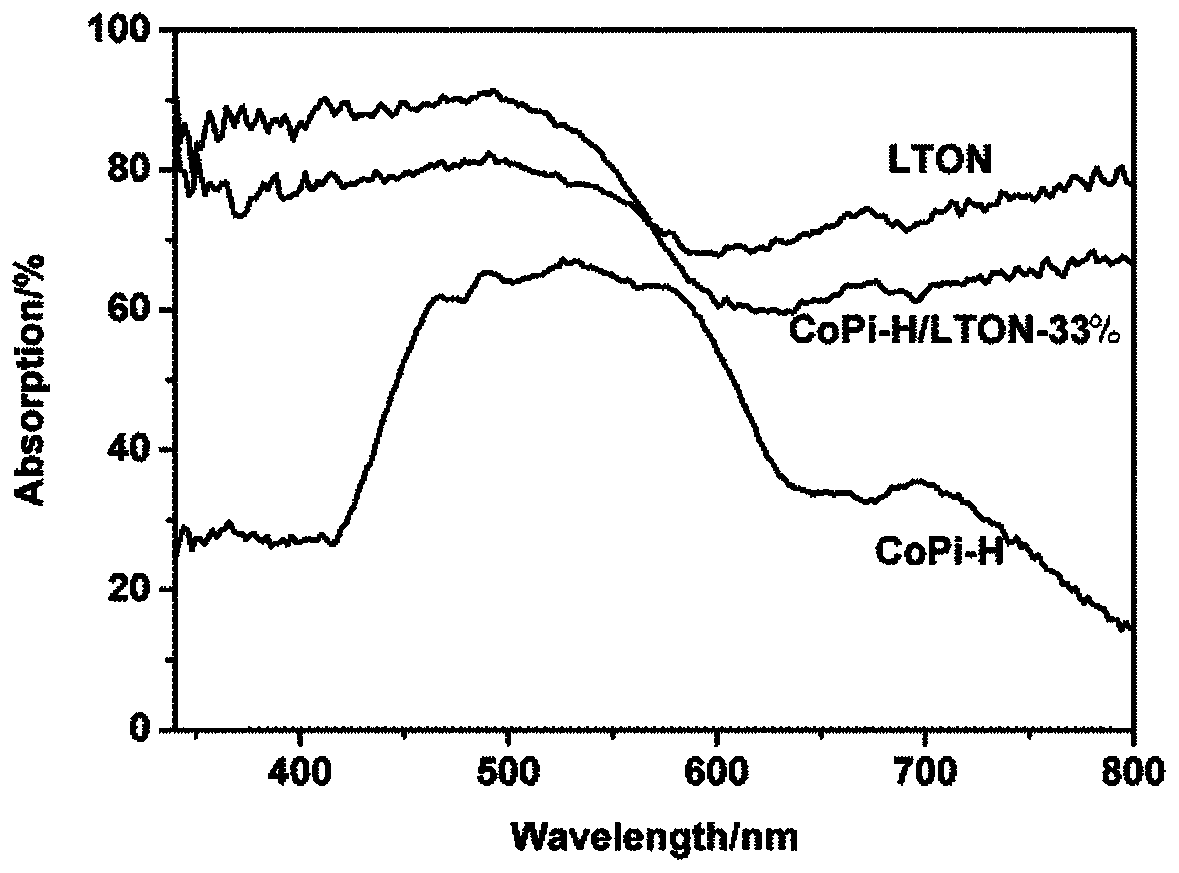A kind of basic cobalt phosphate nanoneedle composite lton photocatalyst and its preparation method and application
A cobalt phosphate nanometer and photocatalyst technology, which is applied in the direction of catalyst activation/preparation, chemical instruments and methods, physical/chemical process catalysts, etc., can solve the problems of high efficiency and low cost, and achieve good visible light catalytic oxygen production performance , promote effective combination, and improve the performance of visible light catalytic oxygen production
- Summary
- Abstract
- Description
- Claims
- Application Information
AI Technical Summary
Problems solved by technology
Method used
Image
Examples
Embodiment 1
[0037] 1) Take 0.04 mol of citric acid monohydrate, 0.01 mol of tetraisopropyl titanate, 0.01 mol of lanthanum nitrate hexahydrate and 0.16 mol of ethylene glycol in sequence, add them into 50 mL of methanol and stir to dissolve to obtain a transparent colloid. The transparent colloid was placed in an oil bath at 70° C. for 4 h, followed by an oil bath at 130° C. for 20 h, and then naturally cooled to room temperature to obtain a brown gel substance. Afterwards, the brown gel substance was heated in an oven at 200° C. for 4 h and then naturally cooled to room temperature to obtain a brown-black powder. Then transfer the brown-black powder to an ash furnace, calcine at 250°C for 1 hour, then cool to room temperature naturally, then heat up to 350°C for 1 hour in the ash furnace, then continue to heat up to 500°C for 12 hours, and then cool to room temperature naturally. In order to ensure the removal of the organic matter, the white precursor powder is obtained. Perform high-t...
Embodiment 2
[0040] 1) Take 0.05 mol of citric acid monohydrate, 0.001 mol of tetraisopropyl titanate, 0.001 mol of lanthanum nitrate hexahydrate and 0.2 mol of ethylene glycol in sequence, add them into 80 mL of methanol and stir to dissolve to obtain a transparent colloid. The transparent colloid was placed in an oil bath at 60°C for 6h, followed by an oil bath at 120°C for 24h, and then naturally cooled to room temperature to obtain a brown gel substance. Afterwards, the brown gel substance was heated in an oven at 200° C. for 2 h and then naturally cooled to room temperature to obtain a brown-black powder. Then transfer the brown-black powder to the ash furnace, calcine at 250°C for 1.5h, then cool to room temperature naturally, then heat up to 350°C for 1.5h in the ash furnace, then continue to heat up to 500°C for 15h, and then cool naturally to Room temperature to ensure the removal of organic matter, that is, to obtain white precursor powder. Perform high-temperature ammonia post-...
Embodiment 3
[0043] 1) Take 0.06 mol of citric acid monohydrate, 0.005 mol of tetraisopropyl titanate, 0.005 mol of lanthanum nitrate hexahydrate and 0.24 mol of ethylene glycol in sequence, add them into 120 mL of methanol and stir to dissolve to obtain a transparent colloid. The transparent colloid was placed in an oil bath at 90° C. for 2 h, followed by an oil bath at 150° C. for 18 h, and then naturally cooled to room temperature to obtain a brown gel substance. Afterwards, the brown gel substance was heated in an oven at 200° C. for 3 h and then naturally cooled to room temperature to obtain a brown-black powder. Then transfer the brown-black powder to the ash furnace, calcine at 250°C for 2 hours, then cool to room temperature naturally, then heat up to 350°C for 2 hours in the ash furnace, then continue to heat up to 500°C for 18 hours, and then cool to room temperature naturally. In order to ensure the removal of the organic matter, the white precursor powder is obtained. Perform ...
PUM
 Login to View More
Login to View More Abstract
Description
Claims
Application Information
 Login to View More
Login to View More - R&D
- Intellectual Property
- Life Sciences
- Materials
- Tech Scout
- Unparalleled Data Quality
- Higher Quality Content
- 60% Fewer Hallucinations
Browse by: Latest US Patents, China's latest patents, Technical Efficacy Thesaurus, Application Domain, Technology Topic, Popular Technical Reports.
© 2025 PatSnap. All rights reserved.Legal|Privacy policy|Modern Slavery Act Transparency Statement|Sitemap|About US| Contact US: help@patsnap.com



